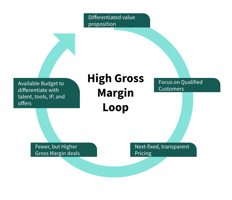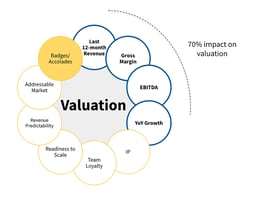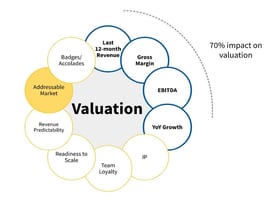We have talked about the two most important attributes that drive ETS valuations: Growth rate and...
Demystifying ETS Valuations Part 8: Team Loyalty and 10 tips on how to strive for it
We have already discussed the criticality of Revenue and Revenue Growth. They are primary drivers of Enterprise Value in ETS businesses. In an Emerging Technology Services (ETS) company, revenue comes when your employees deliver services. Even the most matured and automated services in ETS business have a human-driven delivery component. Therefore, the importance of having a stable team is akin to having recurring or re-ocurring revenue: they both instill confidence in an investor/acquirer that you can scale to the next level rather than fighting fires in existing business.
 Valuation Drivers
Valuation DriversOur choice of the word loyalty here may seem atypical. Most will call it eNPS or eSAT but we feel they do not capture the true essence of what ETS founders need to strive for. In product companies, employees build products that help customers. Their job is to listen to the customer, refine the products, and provide support. However, in an ETS, employees are the product and interaction with them is the customer experience. For them to deliver the best experience, your team members don’t just need to be happy, they must genuinely feel that the company belongs to them hence the word Team Loyalty.
Loyalty is not a measurable metric, it is a concept. It can be measured through multiple metrics. First, we need metrics to measure happiness through measures like eNPS or eSAT. Second, we need to measure the team members’ sense of ownership of the company and that can be done through pointed questions in a survey. Third is a trailing metric: we need to measure the output of team members in terms of the customer experience that they are delivering. The combination of the three can give a sense of the overall health of your team and individual members of the team.
Given some feedback, an ETS founder can take several actions to improve Team Loyalty. Here are our top 10 tips to consider for boosting employee experience:
-
Genuinely care for your team’s happiness. This is harder in an ETS business when the team and your customers can find themselves at odds with each other. How you handle situations where your team complains about a customer or vice-versa will fundamentally define your relationship with your employees. Do not let your customers treat your team poorly, and if in dispute be just to your team. “Customers are always right” but in services, business owners have to be careful that siding always with the customer can make them lose team loyalty.
-
Define the culture of your company. Again, in an ETS, culture is harder to maintain as most of the time your employees are busy delivering client projects and not working towards a single project. In this environment, a deliberate focus on culture is even more important. You need to be more prescriptive about the culture or it drifts quickly due to the loose nature. We recommend actually writing out a culture book and making the talk about culture a part of your daily dialogue.
-
Build continuous improvement of employee experience. Listen to your employees through continuous pulse surveys. Review this data, develop mechanisms to improve their experience. Be innovative with solutions because ETS is a different business than a typical product company. Think of ideas to engage your team with unconventional activities, e.g., virtual lunches.
-
Make the vision of your company inspirational. Define it crisply and communicate it repeatedly and publicly. Again, with the team working on disparate projects in different customer cultures, your team can easily lose their purpose. You have to be deliberate in defining it and reminding them of it.
-
Connect every role’s contribution to the company vision so there is a purpose to their job. Do not make your team feel like “resources” because the word communicates a lack of empathy. Even if they are working for a client, there is a higher purpose they are serving in your company by doing this work. Make sure they know this and are constantly reminded of their importance to the business, and to the higher mission you set.
-
Be transparent about what's good and what's bad in the business to earn their trust. This is true for any business but in an ETS business, where nearly every employee can contribute to a sale (or the lack of it), bringing your team into the fold and asking for their help when you need it is very effective. For example, getting your engineers to become your best sellers is a potential outcome that can be achieved if done right.
-
Maintain a regular cadence of communication – and make it a true priority. It is always advisable to have regular company meetings where updates are discussed, achievements are celebrated, and plans are made. Team members are typically expected to attend such meetings. However, in ETS business, these meetings come at a measurable revenue impact – a team member, by being in a company meeting, reduces their billable time to a customer. A common mistake in this case is to prefer the revenue over the communication and make the meeting optional. This implicitly sends the message that billing is more important than staying connected to the company itself. It has long term consequences when team members complain about not feeling connected to your company, or they show now association to the vision and purpose. It is on the founders of the ETS to set the priorities straight.
-
Always reward your team members for doing the right thing. Again, specific to ETS, many employers may encourage their team members to not be transparent with the customer. This creates an ugly dynamic which takes a toll on your team. Be transparent and encourage everyone else to be transparent as well.
-
Celebrate successes publicly but coach privately. This is not ETS-specific.
-
Develop multi-dimensional employee rewards and recognition plans that relate to your business. See an example below for some suggestions.
|
|
Soft rewards |
Financial rewards |
|
Immediate |
Set up a management-backed peer recognition system where team members can give each other small rewards in a pseudo currency like Tacos, Diamonds, etc. This is used for quick things like someone helped a new engineer learn a concept, they deserve a judos. Important to do two things so this is not a disjoint activity:
|
Give team members the opportunity to convert their pseudo currency they earn in soft rewards into financial rewards. |
|
Short Term |
Accumulate the data from the immediate soft rewards (above) and further recognize those who came at the top, e.g. do a quarterly award for employees who got the most tacos Specific to ETS, create rewards for teams that deliver happy customer outcomes. |
Create a monthly/quarterly bonus system. This can be tied to the overall success of the company/business unit/team/project. It is given out when the set goals are hit. This starts to connect the team member’s day to day work with their rewards and motivates them. |
|
Long Term |
Promotions and title changes are ways to reward long term contributions. You need to gamify the system so employees are always trying to get to the next level. |
Share equity in the company so the team members genuinely feel that they are part owners and the company belongs to them. This encourages them to create long term value and also makes them more forgiving in case a decision you make hurts them in the short term. |
As ETS founders, it is easy to get stuck in the thinking that all problems are tied to sales. It is not. Focus on your team has to always be one of the top three goals of any ETS company and it helps sales too.
The founders of Vixul take a lot of pride in the fact that they built an ETS, Flux7, where team members truly felt at home and owned the company. Contact us if you are an ETS founder and want to discuss how to boost your team’s experience.
The other articles in our "Demystifying ETS Valuations" series are:
-
Demystifying ETS Valuations Part 4: EBITDA and the rule of 40
-
Demystifying ETS Valuations Part 5: Intelectual Property
-
Demystifying ETS Valuations Part 6: Addressable Market
-
Demystifying ETS Valuations Part 7: Revenue Predictability
-
Demystifying ETS Valuations Part 8: Team Loyalty
-
Demystifying ETS Valuations Part 9: Badges And Accolades
-
Demystifying ETS Valuations Part 10a: Readiness To Scale
-
Demystifying ETS Valuations Part 10a: Readiness To Scale




